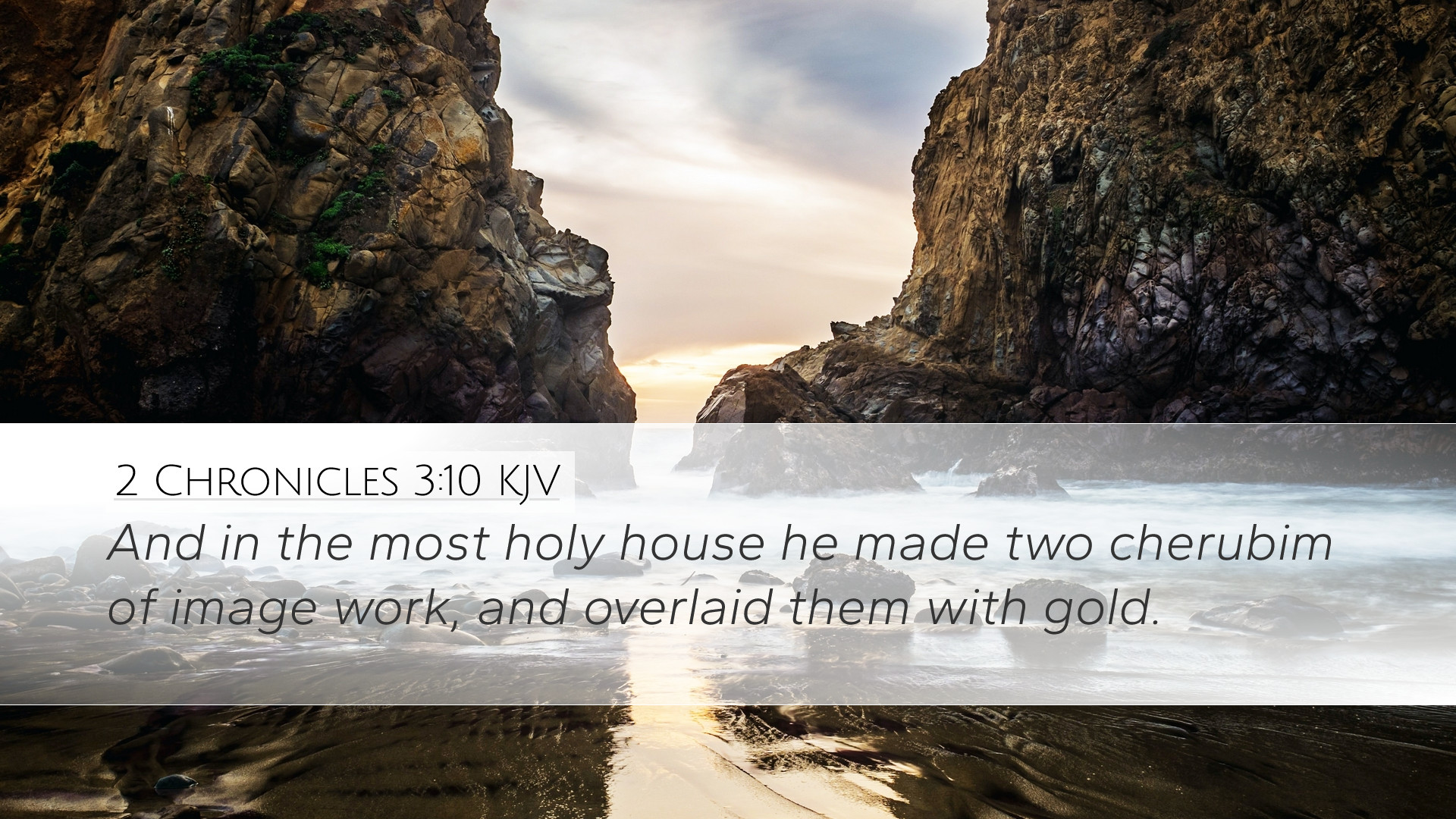Commentary on 2 Chronicles 3:10
2 Chronicles 3:10 states: "And in the most holy house he made two cherubims of image work, and overlaid them with gold." This verse describes an important component of King Solomon's temple, emphasizing the significance of the cherubim and their role in the sacred space dedicated to the presence of God.
Historical Context
This verse is situated within the larger narrative of the building of Solomon's Temple, which represents the culmination of David's desire to provide a permanent dwelling for the Lord. The construction of the temple is a pivotal event in Israel's religious history, reflecting God's covenant with His people and underscoring the concept of divine presence among them. The description of the cherubim highlights the grandeur and holiness associated with the Most Holy Place.
The Significance of Cherubim
According to various commentaries, the cherubim hold multiple layers of meaning:
- Representation of divine guardianship: Cherubim are heavenly beings who serve as guardians of God’s holiness, often depicted in Scripture as protectors of sacred spaces.
- Symbolism of God's glory: The golden cherubim within the temple symbolize the glory of God, serving as a reminder that He is both transcendent and immanent.
- Historical ties to the Mercy Seat: In the tabernacle, the cherubim were positioned over the Mercy Seat, signifying God’s throne on Earth. Their presence in the temple follows this tradition, reinforcing the notion of divine mercy and atonement.
Insights from Commentators
Matthew Henry's Commentary
Matthew Henry articulates that the crafting of the cherubim showcases Solomon's commitment to honoring God through artistry and reverence. He writes, "The work of these cherubims was to show the glory of God, and the dignity of His worship." Henry places emphasis on the fact that these cherubim, made of wood and overlaid with gold, were not merely ornamental but vital to the temple's function. Their dimensions and positioning reflect the grandeur of the divine, inviting worshipers into a space designed for encountering God.
Albert Barnes' Notes
Albert Barnes provides additional insights into the construction specifics, highlighting the craftsmanship involved in making the cherubim. He notes that these figures were made of olive wood and were significant in number and size, standing at ten cubits tall. Barnes states, "These cherubim were designed to represent the angels who are constantly in the presence of God." He further interprets their positioning as a sign of God’s presence, implying that worshipers, approaching the Ark of the Covenant, were enveloped by angelic beings, evoking awe and reverence.
Adam Clarke's Commentary
Adam Clarke emphasizes the theological implications of the cherubim, noting that they serve as reminders of both God's majesty and His mercy. Clarke discusses the intricate details of the design, indicating that their wings spanned from wall to wall, thus creating a formidable barrier between the sacred and the profane. He explains, "This construction signifies that access to God’s holiness is both a privilege and a responsibility, approached with reverence."
Theological Implications
This verse provides rich theological insights relevant for pastors, scholars, and students:
- God’s Immanence and Transcendence: The cherubim symbolize the balance of God’s closeness to humanity and His ultimate holiness, reminding worshipers of the need for reverence in approaching the Lord.
- Worship in Spirit and Truth: The intricate design of the temple teaches about the seriousness of worship. It affirms that worship is not only about the physical act but also about the heart condition of the worshiper.
- The Assurance of God’s Presence: The installation of the cherubim is a testament to God's promise to dwell among His people, encouraging believers that they are never alone in their journey of faith.
Application for Today
The imagery and symbolism presented in 2 Chronicles 3:10 serve as vital reminders for contemporary faith communities:
- Embrace Artistic Expression in Worship: Like Solomon, today's churches should not shy away from integrating art and beauty into worship, reflecting the grandeur of God.
- Prioritize Holiness: In a world that often trivializes the sacred, believers are called to uphold the importance of holiness, both personally and corporately.
- Cultivating a Heart of Worship: Recognizing the cherubim's role invites believers to approach God with an understanding of His majesty and mercy, fostering deeper relationships with Him.
Conclusion
2 Chronicles 3:10 serves as a powerful reminder of God's desire to dwell among His people and the profound symbolism embedded in the construction of the temple. The cherubim reflect divine guardianship, the glory of God, and the mechanisms through which humanity can approach the holiness of the Lord. For pastors, students, and theologians, this verse invites reflection on the nature of worship and the importance of revering the Almighty in all aspects of church life.


